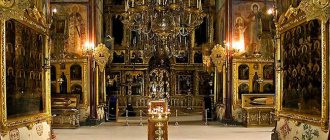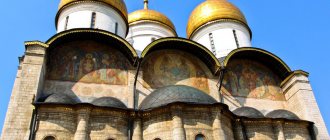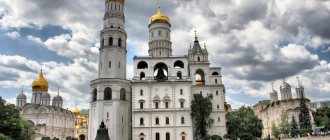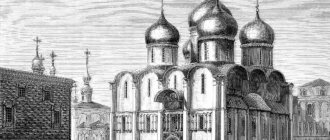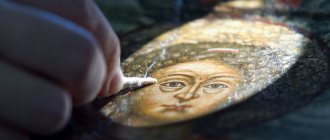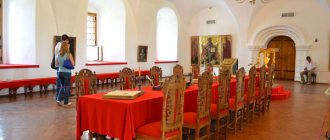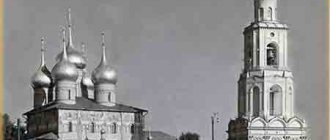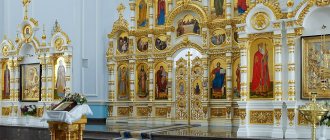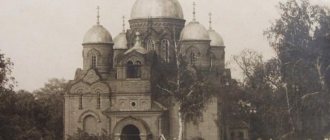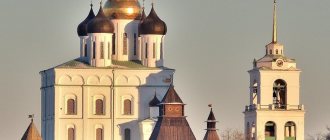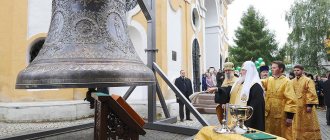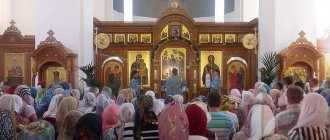| Assumption Cathedral of the Moscow Kremlin |
The Patriarchal Cathedral in honor of the Dormition of the Blessed Virgin Mary in the Moscow Kremlin
of the Russian Orthodox Church, was historically called
the Great
Assumption Cathedral of Moscow
. Not to be confused with the main temple of the Krutitsky courtyard (see), for some time called the Small Assumption Cathedral of Moscow
- Altars: Dormition of the Blessed Virgin Mary (main); Vmch. Demetrius of Thessalonica (altarside); Praise of the Blessed Virgin Mary (altar); App. Peter and Paul (altar)
- Address: Russia, Moscow, Kremlin, Sobornaya sq.
- On the map: Yandex.Map, Google map
For six centuries, the Assumption Cathedral of the Moscow Kremlin was the state and cult center of Russia: great princes were installed here, and appanages swore allegiance to them, crowned them, and crowned emperors. In the Assumption Cathedral, bishops, metropolitans and patriarchs were elevated to rank, state acts were read out, prayers were served before military campaigns and in honor of victories.
Story
The first stone building of the cathedral, the “Church of Stone on Moscow Square,” was founded in 1326 by the first Moscow Metropolitan, Saint Peter and Prince John Kalita, on the site of a previously existing, presumably wooden one. The impetus for construction was Moscow's acquisition of the status of the capital city. The Moscow Assumption Cathedral - the first stone church in Moscow - was designed to replace the Vladimir Assumption Cathedral as the main temple of Rus'. In the same year, Saint Peter rested in the cathedral under construction and was buried on the north side of the temple, near the altar. In honor of the reposed metropolitan, Prince John Kalita built a chapel in the cathedral in honor of the Adoration of the chains of the Apostle Peter. The cathedral was consecrated on August 14, 1327 by Saint Prokhor of Rostov on the eve of the Feast of the Dormition of the Virgin Mary.
At the end of the century, Grand Duke John Vasilyevich, who united all the Russian principalities under the rule of Moscow, began the creation of a new residence with the reconstruction of the Assumption Cathedral. In 1472, the temple was dismantled to its very foundations, and the relics of St. Peter were discovered. Pskov masters Krivtsov and Myshkin erected a new cathedral, but it unexpectedly collapsed. Then the Grand Duke invited the architect Aristotle Fioravanti from Italy. Under his leadership, following the model of the Vladimir Cathedral, a building was built in 1475-1479 that has since adorned the Moscow Kremlin. On August 20, 1479, Metropolitan of Moscow Saint Gerontius consecrated the temple. The relics of St. Peter were returned to the cathedral.
The ceremonial appointment determined special attention to the decoration of the temple. The cathedral's murals, numerous icons and various utensils are works of art of world significance. The paintings of 1642-1643 and the grandiose iconostasis of 1653 determined its internal appearance for a long time. In front of the iconostasis are the prayer places of the king, queen and patriarch. The most interesting is the royal prayer place. An openwork bronze tent rises in the southwestern corner. The oldest monument of applied art in the cathedral is its southern doors (brought to Moscow from the Suzdal Cathedral, dating back to the beginning of the century); 20 images on biblical themes are written on them in gold over black lacquer.
During the Patriotic War of 1812, the cathedral was plundered by Napoleonic troops. Subsequently, from part of the silver captured from the French by the Russian Cossacks, a magnificent chandelier was forged, which was hung in the center of the cathedral.
At the end of the 19th and beginning of the centuries, during the restoration of the cathedral, several frescoes from the turn of the 16th century were discovered in the altar and on the altar barrier. In 1906, scientific restoration was completed.
On November 21, 1917, the cathedral hosted the enthronement of Saint Tikhon (Bellavin), who was newly elected to the Moscow patriarchal throne after a two-century break [1].
Soon after this, the cathedral was turned into a museum. When creating its exhibition, the staff tried to preserve its interior as much as possible. Thanks to constant restoration work, almost all icons and paintings were revealed from later records. At the same time, no scientific restoration of the cathedral was carried out in Soviet times.
Divine services in the cathedral resumed in 1990.
| Moscow Assumption Patriarchal Cathedral in the Kremlin. Photo December 4, 2015 |
Shrines
During its existence, the temple turned into a storage place for revered Christian shrines:
- The Nail of the Lord is one of the 4 nails with which Jesus was crucified on the cross.
- Scrap from Christ's robe
- Image of the Vladimir Mother of God
- Icon of Our Lady Hodegetria
- Staff of St. Peter, Metropolitan of Kyiv and All Rus'
The Robe of the Lord came to Russian land in 1625 as a gift from the Shah of Persia to Tsar Mikhail Fedorovich. To commemorate this, the Russian Orthodox Church instituted a celebration - the Position of the Lord's Robe. To preserve the relic, a special tent or canopy was created. It represents a roof similar to the cover over the Holy Sepulcher. The canopy consists of copper plates with gilding and silvering. In addition, the openwork part is decorated with mica of different colors. The tent was erected in the southwestern part of the building.
Architecture
Aristotle Fioravanti quite accurately repeated the model - the Assumption Cathedral in Vladimir - an ancient cross-domed temple, but created a structure that was fundamentally new in its architecture. The three-nave, five-domed cathedral is made of small blocks of white stone. It is particularly monolithic: all divisions are equal in size, the altar apses are flattened and hidden by massive blades, the large domes are close together. The smoothness of the walls is only emphasized by narrow slit windows and a small arched frieze. Chronicles noted that the building looks “like a single stone.”
The spacious interior contrasts with the somewhat harsh appearance of the facades. There, the originality of its architecture is more strongly felt: the use of new technical means made it possible to enlarge all the divisions of the temple; thin round pillars do not crowd out the space, creating the impression of a huge palace hall. The cathedral amazed contemporaries with its “majesty and height, and lightness and space.” Until the end of the 17th century, the Assumption Cathedral served as a model for the construction of many cathedrals in the cities and monasteries of pre-Petrine Rus'.
Patronal holidays[edit]
Dormition of the Blessed Virgin Mary
- August 28
Nicholas the Wonderworker, Archbishop of Myra, Saint
— May 22, December 19
Sergius of Radonezh, Venerable
— Cathedral of Moscow Saints, July 18, October 8
mural painting
The best masters were hired to paint the first altar church. The oldest frescoes of the Moscow Kremlin are preserved on the altar barrier - images of ascetic monks, painted in 1481 by the artel of the great icon painter Dionysius. Altar compositions of the same time are also known - “The Seven Sleeping Youths of Ephesus”, “The Forty Martyrs of Sebaste”, “The Adoration of the Magi” and others. Then the Assumption Cathedral was painted in 1513-1515. In 1642-1643, this painting was knocked down with plaster, having previously removed the “translations”, and a team of 150 artists led by the royal isographers Ivan and Boris Paisein and Sidor Pospeev completed the existing mural.
The architecture and murals of the temple create an image of space, where the vaults symbolize the sky carried by the pillars of the cathedral. As a rule, images of martyrs are placed on the pillars, who support the Church with their lives and martyrdom, just as the pillars support the arch.
The painting of the Assumption Cathedral is distinguished by thoughtfulness and clarity of construction. The chapters contain various images of God, the upper parts of the walls are occupied by illustrations of the Gospel, their arrangement corresponds to the sequence of services throughout the year. The painting on the second tier from the top on the southern and northern walls tells the story of the miraculous birth of the Virgin Mary and Her childhood. The next row is occupied by illustrations of the Akathist in honor of the Mother of God. An interesting feature of the painting is the image of the seven Ecumenical Councils in the lower tiers of the walls. On the western wall of the temple there is traditionally a huge composition of the Last Judgment. Numerous figures of martyrs are painted on the round pillars.
How to get there[edit]
Address:
142436, Moscow region, Noginsky district, p/o Borovkovo, village. Stromyn, Church of the Assumption of the Mother of God.
Directions:
from Moscow, from the bus station (Shchelkovskaya metro station) bus (express) No. 360 (Moscow-Chernogolovka-Dubrovo). Ask the driver to stop in Stromyn at the 2nd stop near the Temple (7-10 minutes after Chernogolovka). Or, from the bus station (Shchelkovskaya metro station) bus (express or regular, or minibus) No. 320 (Moscow-Chernogolovka). Next, from Chernogolovka take bus number 24 to Stromyn (get off in Stromyn, at the 2nd stop, near the Temple).
Telephone:
8(916) 156-85-32. Father Alexander Parkhomenko.
Email:
Iconostasis
The iconostasis of the cathedral was created in 1653 on the initiative of Patriarch Nikon. Its sixty-nine icons illustrate the entire biblical history of mankind. The top row is the forefathers - the Old Testament period preceding the incarnation of Christ. In the next prophetic row, the prophets are depicted in front of Our Lady of the Sign; they hold scrolls with the texts of prophecies about Christ. In the festive row there are icons dedicated to the main events of the life of Christ. The main one is the Deisis rite, reminiscent of the Second Coming: the Mother of God, John the Baptist and, in accordance with Greek tradition, the twelve apostles stand before Christ the Pantocrator in prayerful poses.
Activities of the parish[edit]
In 1997, a Sunday school was formed at the Church of the Assumption of the Mother of God. The children learned the basics of the Orthodox faith, church sacraments and holidays, learned chants and poems, and went on excursions to holy places.
Since 2002, children and Sunday school teachers regularly hold Christmas and Easter concerts in the church for all parishioners and festivities on Maslenitsa.
During school holidays, students of the Orthodox school are taken on pilgrimage trips: to the Trinity-Sergius Lavra, to the Pavlovo Posad Monastery, to the Church of the Great Martyr. Nikita in the village of Byvalino, in the Kirzhach convent, in the Epiphany Cathedral and the Tikhvin Church in the city of Bogorodsk, at the holy springs. Three children from the Sunday school class of 2003 are still serving as altar servers.
In 2002, with the blessing of the rector, work began with children's institutions: Dubrovsky secondary educational school No. 83, Chernogolovsky experimental elementary school No. 79 and Chernogolovsky preschool institution (MDOU d/c No. 74 “Rainbow”). At first, the children with their parents and mentors came to the temple on excursions and watched Sunday school performances. Now they themselves organize holidays for other children and adults.
Icons
The collection of icons from the 12th to 17th centuries in the Assumption Cathedral is one of the richest in the world. Most of them were written in Moscow for the cathedrals of the 14th and centuries, others were brought to Moscow from ancient cities during the period of gathering Russian lands. One can note the oldest Russian icon - the double-sided “Our Lady Hodegetria” and “St. George”, “The Ardent Eye of the Savior”, “The Trinity”, two copies of the “Our Lady of Vladimir”, the temple image “The Dormition”, “The Present Queen”, “Apostles Peter and Paul ", "Metropolitan Peter in the Life" and many others. Associated with the name of St. Peter of Moscow is a small icon called “Our Lady of Petrovsk,” which, according to legend, he painted himself, and which was subsequently kept in the Assumption Cathedral as one of the main Moscow shrines.
Assumption Cathedral in Moscow on the map
- Takachiho Gorge in Japan
- 10 places to visit in Israel
- Sights of Valencia
- Traditions and customs of India
- Cuba hotels 3 stars all inclusive
- 13 best thermal spas in Hungary
- Kemer hotels with water park
- Mariinsky Theater - a bright pearl of St. Petersburg
- Berlin travel guide – tips from locals
- How to buy a ticket for air sales: instructions, tips
- Tours to Crete (Greece) for 9 nights, 2 adults + 1 child, 3-5* hotels, all inclusive from 88,481 rubles for THREE – September
- Sanatoriums of Crimea with treatment
Tomb
Since 1326, when Metropolitan Peter was buried in the unfinished church, the cathedral served as the tomb of Russian high priests.
There are 19 tombs in the cathedral. From the end of the 16th century, brick tombstones with white stone epitaphs began to be installed over the tombs, and at the beginning of the century, the tombstones were enclosed in metal covers. The burial places of holy priests are highlighted by high tents - vestibules.
The relics of the Moscow wonderworkers Peter (+ 1326), Jonah (+ 1461), Philip (+ 1569) and Hermogenes (+ 1612) rest in wooden reliquaries decorated with metal plates.
The following were buried in the cathedral tomb [2]:
Metropolitans of Moscow
- Theognostus (+ 1353)
- Cyprian (+ 1406)
- Photius (+ 1431)
- Philip I (+ 1473)
- Gerontius (+ 1489)
- Simon (+ 1511)
- Macarius (+ 1563)
Patriarchs of Moscow
- Job (+ 1607)
- Filaret (+ 1633)
- Joasaph I (+ 1640)
- Joseph (+ 1652)
- Joasaph II (+ 1672)
- Pitirim (+ 1673)
- Joachim (+ 1690)
- Adrian (+ 1700)
Royal prayer place
The royal place of prayer - the Monomakh Throne - was created in 1551 for the first Russian Tsar Ivan the Terrible. Its performers were probably Novgorod carvers. Here are presented various motifs and techniques of carving that were once widespread in Rus'. At the base there are four round sculptures - images of fantastic predatory animals. They carry a square structure with a complex shape of columns, balusters, valances, topped with an intricate tent with numerous kokoshniks, rosettes and vases. Twelve bas-reliefs on the walls illustrate “The Tale of the Princes of Vladimir,” which tells about the bringing of royal regalia to Rus' - the Monomakh cap, barm (ceremonial mantle) and other items.
Used materials
- Page of the official website of the Russian Orthodox Church:
- Website page of the State Historical and Cultural Museum of the Moscow Kremlin Reserve:
- “Assumption Patriarchal Cathedral in the Kremlin”, page of the Russian Orthodoxy
: - Sergievskaya I. G. “Pantheons of the Kremlin.” Series “The Greatest Necropolises of the World” M., Eksmo Publishing House, 2013, p. 16.
[1] “A prayer service before the relics of St. Tikhon preceded the opening of the Council of Bishops of the Russian Orthodox Church,” official website of the Russian Orthodox Church, November 29, 2022,
[2] Sergievskaya I. G. “Pantheons of the Kremlin.” Series “The Greatest Necropolises of the World” M., Eksmo Publishing House, 2013, p. 16.
[3] “Protopresbyter Vasily Ivanovich Platonov,” biographical encyclopedia
,
Opening hours and visiting rules
The museum receives visitors every day (except Thursday):
- from 10 to 18 hours (15.05-30.09)
- from 10 to 17 hours (1.10-14.05)
During public events on Red Square, the Kremlin museums are closed. The special location of the cathedral on the territory of the Kremlin dictates strict adherence to rules for visitors. They regulate the requirements for tourists:
- Must have a ticket to the museum.
- The Borovitsky and Trinity gates are open to allow people through.
- Photography inside the museum is prohibited.
